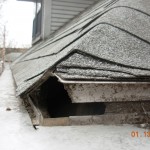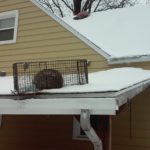How Weather Influences Nuisance Wildlife Behavior
 The cold finally found us! Here in the Akron, Canton, Kent area this past weekend we received our first really good blast of winter. And while we luckily avoided much of the snowfall other areas of the country experienced, the wind and arctic temps are surely felt.
The cold finally found us! Here in the Akron, Canton, Kent area this past weekend we received our first really good blast of winter. And while we luckily avoided much of the snowfall other areas of the country experienced, the wind and arctic temps are surely felt.
As winter tightens its grip, the behavior of nuisance wildlife in Northeast Ohio is affected by these weather changes. In this week’s post, we’ll explore how various species respond to winter weather conditions and how these factors can impact their interactions with homes and humans.
Squirrels & Raccoons Are Active All Winter
Despite the cold, squirrels and raccoons remain active during winter. Raccoons, grey squirrel, fox squirrels, flying squirrels, and red squirrels do not hibernate. This means that these animals enter our client’s homes throughout the year–even now when it is bitterly cold outside.
Here are some tidbits to think about when it comes to squirrels, raccoons and cold weather in January:
Flying Squirrels often group up the colder it gets. One of the unique things about flying squirrels is that they often become communal in the winter. It is assumed that they do this to share body heat. Multiple family units can take up residence in a protected spot and this causes troubles for the homeowner hosting one of these squirrel parties.
See out BLOG POST ON WINTER FLYING SQUIRRELS for more.
 For RACCOONS this is certainly not the time for hibernation- it’s the beginning of mating season. The extreme cold temperatures will keep raccoons nestled in their dens for days at a time. But, if food or the opposite sex is near it doesn’t really matter how cold it is-they’ll be out. Expect them to be more active during warming trends.
For RACCOONS this is certainly not the time for hibernation- it’s the beginning of mating season. The extreme cold temperatures will keep raccoons nestled in their dens for days at a time. But, if food or the opposite sex is near it doesn’t really matter how cold it is-they’ll be out. Expect them to be more active during warming trends.
Here is an older post in which we highlighted raccoon movement during winter : RACCOON ACTIVITY IN WINTER.
All of the SQUIRRELS are also in the first of two mating seasons. Just like raccoons, squirrels are winter breeders. Squirrels breed twice a year and December-January is the first breeding season of the year for squirrels. So even if its really cold out, you can expect to see some squirrels actively chasing each other as their biological needs trumps the weather. Here is a link to SQUIRRELS IN OHIO from the ODNR.
Bats & Groundhogs are Not Out
The two nuisance species we deal with that stop moving about with these very cold temperatures are bats and groundhogs. Both of these species go into a state of hibernation in the winter. They don’t re-emerge until the days are warmer.
Bats in a home can sometimes be spotted during the winter due to some unusual circumstances. See this post, WINTER BATS, for more on this unusual phenomenon.
Birds Looking for Warmth | Starlings and Sparrows
In the winter there is an uptick of calls for birds in the basement and in vents.
Sparrows and Starlings are the two invasive & un-protected species that are common users of our homes. In the winter, one of their main goals is to stay as warm as possible. That’s why you’ll see them grouped on sunny roofs or huddled around vents expelling warm air from buildings.
These two species are also known to “follow the warmth” and go into pipes from which the warmth is coming. This is how these birds wind up in basements, dryer vents, bathroom vents, and other places not normally expected. You can’t blame them for trying to keep warm. But when they get in, they sometimes can’t get back out.
See this older post on BIRDS IN THE BASEMENT IN WINTER for more on this topic.
Home Entry Opportunity from Storms
Many of the nuisance animal species we deal with here in the Akron, Canton, Kent Ohio area are opportunists. They find weaknesses in our homes’ exteriors and use it to their advantage.
The winter storms we experienced this past weekend with those unforgiving winds surely created some opportunities for nuisance animals here in our region. Siding, soffits, and vents were all surely loosened from the winds. Add that to the freeze/thaw cycle that makes building materials move and its easy to see how unplanned openings into buildings are created. These openings are very inviting to wildlife looking for more warmth and shelter.
If building materials come loose during the winter storms, waiting ’til spring to resecure them could have the unintended consequence of inviting in nuisance wildlife.
So if you suspect there is an issue, our advice is to get it looked at in short order.
As winter weather tests the resilience of both wildlife and homes, understanding the seasonal behaviors of nuisance animals becomes crucial. By being aware of these patterns, homeowners can take proactive measures to safeguard their properties and coexist harmoniously with the wildlife that shares their environment.
Give Frontline Animal Removal a call for all of your wintertime nuisance animal removal needs!

